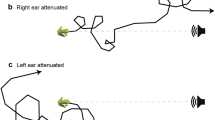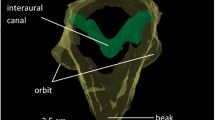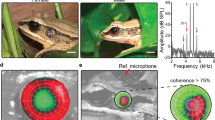Summary
-
1)
Laser vibrometry was used to study the frequency response of the eardrum as a function of the angle of sound incidence in four species of anurans. Furthermore, the transmission of sound via the body wall and lungs to the internal side of the eardrum and the influence of this lung input on the vibrations of the eardrum were studied.
-
2)
The frequency response of the eardrum was directional in a broad frequency range around its peak. How-ever, the strongest directionality occurred in a narrow frequency range, which did not coincide with the main frequencies of the conspecific advertisement calls.
-
3)
The maximum directionality in this narrow frequency range was 10–25 dB. The maximum directionality at the advertisement call frequencies never exceeded 5–10 dB.
-
4)
Attenuation of the lung input by covering the body wall with vaseline had a significant influence on the frequency response of the eardrum in all species, albeit only in a relatively narrow frequency range.
-
5)
An increase of lung volume caused the narrow frequency range of maximum directionality to move towards lower frequencies. The shift was not sufficient for the maximum directionality to reach the advertisement call frequencies.
Similar content being viewed by others
References
Aertsen AMHJ, Vlaming MSMG, Eggermont JJ, Johannesma PIM (1986) Directional hearing in the grassfrog (Rana temporaria L.). II. Acoustics and modelling of the auditory periphery.Hearing Res 21:17–40
Anson M, Pinder AC, Keating MJ, Chung SH (1985) Acoustic vibration of the amphibian eardrum studied by white noise analysis and holographic interferometry.J Acoust Soc Am 78:916–923
Eggermont JJ (1988) Mechanisms of sound localization in anurans. In: Fritzsch B, Ryan MJ, Wilczynski W, Hetherington TE, Walkowiak W (eds) The evolution of the amphibian auditory system. John Wiley & Sons, New York Chichester Brisbane Toronto Singapore, pp 307–336
Ehret G, Tautz J, Schmitz B, Narins PM (1990) Hearing through the lungs: Lung-eardrum transmission of sound in the frog Eleutherodactylus coqui. Naturwissenschaften 77:192–194
Feng AS (1980) Directional characteristics of the acoustic receiver of the leopard frog (Rana pipiens): A study of eighth nerve auditory responses. J Acoust Soc Am 68:1107–1114
Fletcher NH, Thwaites S (1979) Physical models for the analysis of acoustical systems in biology. Q Rev Biophysics 12:25–65
Gerhardt HC (1982) Sound pattern recognition in some North American treefrogs (Anura: Hylidae): Implications for mate choice. Am Zool 22:581–595
Gerhardt HC, Rheinlaender J (1980) Accuracy of sound localization in a miniature dendrobatid frog. Naturwissenschaften 67:362–363
Jørgensen MB, Gerhardt HC (1991) Directional hearing in the gray tree frog, Hyla versicolor: Eardrum vibrations and phonotaxis. J Comp Physiol A169:177–183
Jørgensen MB, Schmitz B, Christensen-Dalsgaard J (1991) Biophysics of directional hearing in the frog Eleutherodactylus coqui. J Comp Physiol A168:223–232
Klump GM, Gerhardt HC (1989) Sound localization in the barking treefrog. Naturwissenschaften 76:35–37
Michelsen A, Jørgensen MB, Christensen-Dalsgaard J, Capranica RR (1986) Directional hearing of awake, unrestrained treefrogs. Naturwissenschaften 73:682–683
Michelsen A, Larsen ON (1978) Biophysics of the ensiferan ear. I. Tympanal vibrations in bushcrickets (Tettigoniidae) studied with laser vibrometry. J Comp Physiol 123:193–203
Narins PM, Ehret G, Tautz J (1988) Accessory pathway for sound transfer in a neotropical frog. Proc Natl Acad Sci USA 85:1508–1512
Palmer AR, Pinder AC (1984) The directionality of the frog ear described by a mechanical model. J Theor Biol 110:205–215
Passmore NI, Capranica RR, Telford SR, Bishop PJ (1984) Phonotaxis in the painted reed frog (Hyperolius marmoratus). J Comp Physiol A154:189–197
Pinder AC, Palmer AR (1983) Mechanical properties of the frog ear: vibration measurements under free- and closed-field acoustic conditions. Proc R Soc Lond B219:371–396
Rheinlaender J, Gerhardt HC, Yager DD, Capranica RR (1979) Accuracy of phonotaxis by the green treefrog (Hyla cinerea).J Comp Physiol 133:247–255
Wilczynski W, Resler C, Capranica RR (1987) Tympanic and extratympanic sound transmission in the leopard frog. J Comp Physiol A161:659–669
Author information
Authors and Affiliations
Rights and permissions
About this article
Cite this article
Jørgensen, M.B. Comparative studies of the biophysics of directional hearing in anurans. J Comp Physiol A 169, 591–598 (1991). https://doi.org/10.1007/BF00193548
Accepted:
Issue Date:
DOI: https://doi.org/10.1007/BF00193548




